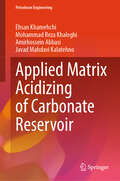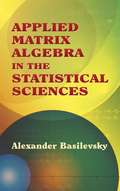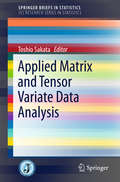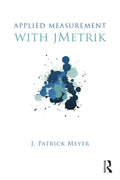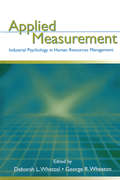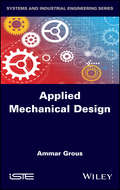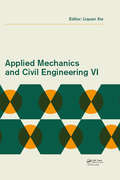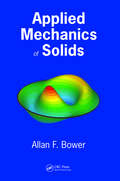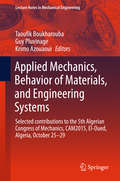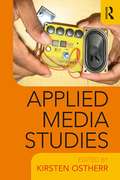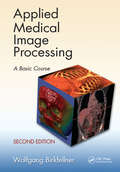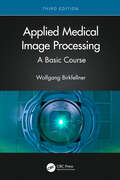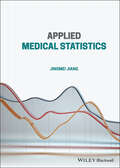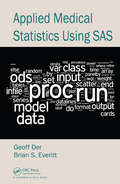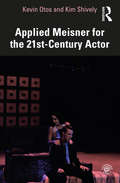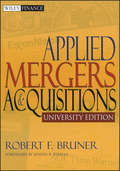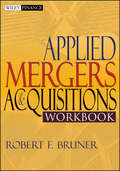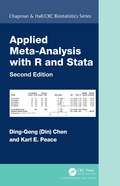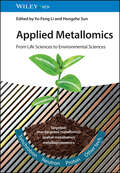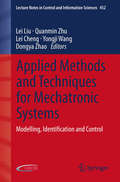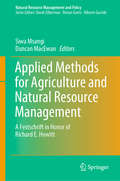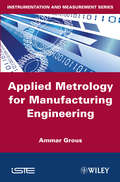- Table View
- List View
Applied Matrix Acidizing of Carbonate Reservoir (Petroleum Engineering)
by Ehsan Khamehchi Mohammad Reza Khaleghi Amirhossein Abbasi Javad Mahdavi KalatehnoThis book enhances readers’ understanding of matrix acidizing and its pivotal role in the oil and gas industry. It is a comprehensive guide to maximizing reservoir performance. The book explores carbonate reservoirs, where acid meets rock, and indicates pathways to increased well productivity. Based on extensive research, the book has insights for students, professionals, and researchers and all those interesting in realizing the full potential of oil and gas reservoirs.
Applied Matrix Algebra in the Statistical Sciences
by Alexander BasilevskyThis comprehensive text covers both applied and theoretical branches of matrix algebra in the statistical sciences. It also provides a bridge between linear algebra and statistical models. Appropriate for advanced undergraduate and graduate students, the self-contained treatment also constitutes a handy reference for researchers. The only mathematical background necessary is a sound knowledge of high school mathematics and a first course in statistics.Consisting of two interrelated parts, this volume begins with the basic structure of vectors and vector spaces. The latter part emphasizes the diverse properties of matrices and their associated linear transformations--and how these, in turn, depend upon results derived from linear vector spaces. An overview of introductory concepts leads to more advanced topics such as latent roots and vectors, generalized inverses, and nonnegative matrices. Each chapter concludes with a section on real-world statistical applications, plus exercises that offer concrete examples of the applications of matrix algebra.
Applied Matrix and Tensor Variate Data Analysis (SpringerBriefs in Statistics)
by Toshio SakataThis book provides comprehensive reviews of recent progress in matrix variate and tensor variate data analysis from applied points of view. Matrix and tensor approaches for data analysis are known to be extremely useful for recently emerging complex and high-dimensional data in various applied fields. The reviews contained herein cover recent applications of these methods in psychology (Chap. 1), audio signals (Chap. 2) , image analysis from tensor principal component analysis (Chap. 3), and image analysis from decomposition (Chap. 4), and genetic data (Chap. 5) . Readers will be able to understand the present status of these techniques as applicable to their own fields. In Chapter 5 especially, a theory of tensor normal distributions, which is a basic in statistical inference, is developed, and multi-way regression, classification, clustering, and principal component analysis are exemplified under tensor normal distributions. Chapter 6 treats one-sided tests under matrix variate and tensor variate normal distributions, whose theory under multivariate normal distributions has been a popular topic in statistics since the books of Barlow et al. (1972) and Robertson et al. (1988). Chapters 1, 5, and 6 distinguish this book from ordinary engineering books on these topics.
Applied Measurement with jMetrik
by J. Patrick MeyerjMetrik is a computer program for implementing classical and modern psychometric methods. It is designed to facilitate work in a production environment and to make advanced psychometric procedures accessible to every measurement practitioner. Applied Measurement with jMetrik reviews psychometric theory and describes how to use jMetrik to conduct a comprehensive psychometric analysis. Each chapter focuses on a topic in measurement, describes the steps for using jMetrik, and provides one or more examples of conducting an analysis on the topic. Recommendations and guidance for practice is provided throughout the book.
Applied Measurement: Industrial Psychology in Human Resources Management
by Deborah L. Whetzel George R. WheatonAn updated version of Deborah Whetzel and George Wheaton's earlier volume, this text is a well-organized sourcebook for fundamental practices in industrial psychology and human resources management. Applied Measurement describes the process of job analysis and test development with practical examples and discusses various methods for measuring job performance. Its primary purpose is to provide practical, systematic guidance on how to develop the various kinds of measurement instruments frequently used in the fields of industrial psychology and human resources management to assess personnel. With easy to follow guidance written in straightforward language, Applied Measurement contains three new chapters focusing on training and experience measures, assessment centers, and methods for defending the content validity of tests; includes contributions from many prominent researchers in the field, all of whom have had a great deal of applied experience; begins each chapter with an overview describing the job analysis or measurement method; and uses one job, that of an electrician, as an example throughout the book so that readers can easily understand how to apply job analysis data for the purposes of test development and job performance measurement. This practical, concise book is recommended for students and entry-level practitioners in the fields of industrial psychology and human resources.
Applied Mechanical Design: Solved Case Studies And Projects
by Ammar GrousThis book is the result of lessons, tutorials and other laboratories dealing with applied mechanical design in the universities and colleges. In the classical literature of the mechanical design, there are quite a few books that deal directly and theory and case studies, with their solutions. All schools, engineering colleges (technical) industrial and research laboratories and design offices serve design works. However, the books on the market remain tight in the sense that they are often works of mechanical constructions. This is certainly beneficial to the ordinary user, but the organizational part of the functional specification items is also indispensable.
Applied Mechanics and Civil Engineering VI
by Liquan XieApplied Mechanics and Civil Engineering VI includes the contributions to the 6th International Conference on Applied Mechanics and Civil Engineering (AMCE 2016, Hong kong, China, 30-31 December 2016), and showcases the challenging developments in the areas of applied mechanics, civil engineering and associated engineering practice. The book covers a wide variety of topics:- Applied mechanics and its applications in civil engineering;- Bridge engineering;- Underground engineering;- Structural safety and reliability;- Reinforced concrete (RC) structures;- Rock mechanics and rock engineering;- Geotechnical in-situ testing & monitoring;- New construction materials and applications;- Computational mechanics;- Natural hazards and risk, and- Water and hydraulic engineering. Applied Mechanics and Civil Engineering VI will appeal to professionals and academics involved in the above mentioned areas, and it is expected that the book will stimulate new ideas, methods and applications in ongoing civil engineering advances.
Applied Mechanics of Solids
by Allan F. BowerModern computer simulations make stress analysis easy. As they continue to replace classical mathematical methods of analysis, these software programs require users to have a solid understanding of the fundamental principles on which they are based.Develop Intuitive Ability to Identify and Avoid Physically Meaningless PredictionsApplied Mechanics o
Applied Mechanics, Behavior of Materials, and Engineering Systems: Selected contributions to the 5th Algerian Congress of Mechanics, CAM2015, El-Oued, Algeria, October 25 – 29 (Lecture Notes in Mechanical Engineering)
by Taoufik Boukharouba Guy Pluvinage Krimo AzouaouiThis book covers a variety of topics in mechanics, with a special emphasis on material mechanics. It reports on fracture mechanics, fatigue of materials, stress-strain behaviours, as well as transferability problems and constraint effects in fracture mechanics. It covers different kind of materials, from metallic materials such as ferritic and austenitic steels, to composites, concrete, polymers and nanomaterials. Additional topics include heat transfer, quality control and reliability of structures and components. Furthermore, the book gives particular attention to new welding technologies such as STIR welding and spray metal coating, and to novel methods for quality control, such as Taguchi design, fault diagnosis and wavelet analysis. Based on the 2015 edition of the Algerian Congress of Mechanics (Congrès Algérien de Mécanique, CAM), the book also covers energetics, in terms of simulation of turbulent reactive flow, behaviour of supersonic jet, turbulent combustion, fire induced smoke layer, and heat and mass transfer, as well as important concepts related to human reliability and safety of components and structures. All in all, the book represents a complete, practice-oriented reference guide for both academic and professionals in the field of mechanics.
Applied Media Studies: Theory and Practice
by Kirsten OstherrIn the age of the maker movement, hackathons and do-it-yourself participatory culture, the boundaries between digital media theory and production have dissolved. Multidisciplinary humanities labs have sprung up around the globe, generating new forms of hands-on, critical and creative work. The scholars, artists, and scientists behind these projects are inventing new ways of doing media studies teaching and research, developing innovative techniques through experimental practice. This book of case studies brings together practitioners of applied media studies, providing a roadmap for how and why to do hands-on media work in the digital age.
Applied Medical Image Processing: A Basic Course
by Wolfgang BirkfellnerA widely used, classroom-tested text, Applied Medical Image Processing: A Basic Course delivers an ideal introduction to image processing in medicine, emphasizing the clinical relevance and special requirements of the field. Avoiding excessive mathematical formalisms, the book presents key principles by implementing algorithms from scratch and usin
Applied Medical Image Processing: A Basic Course
by Wolfgang BirkfellnerA widely used, classroom-tested text, Applied Medical Image Processing: A Basic Course delivers an ideal introduction to image processing in medicine, emphasizing the clinical relevance and special requirements of the field. Avoiding excessive mathematical formalisms, the book presents key principles by implementing algorithms from scratch and using simple MATLAB®/Octave scripts with image data and illustrations on an accompanying companion website. Organized as a complete textbook, it provides an overview of the physics of medical image processing and discusses imaging physics, clinical applications of image processing, image formats and data storage, intensity transforms, filtering of images and applications of the Fourier transform, three-dimensional spatial transforms, volume rendering, image registration, tomographic reconstruction and basic machine learning.This Third Edition of the bestseller: Contains a brand-new chapter on the basics of machine learning Devotes more attention to the subject of color space Includes additional examples from radiology, internal medicine, surgery, and radiation therapy Incorporates freely available programs in the public domain (e.g., GIMP, 3DSlicer, and ImageJ) when applicable Beneficial to students of medical physics, biomedical engineering, computer science, applied mathematics, and related fields, as well as medical physicists, radiographers, radiologists, and other professionals, Applied Medical Image Processing: A Basic Course, Third Edition is fully updated and expanded to ensure a perfect blend of theory and practice.Wolfgang Birkfellner studied theoretical physics at, and holds a Ph.D in medical physics from, the University of Vienna, Austria. Currently, he is heading the Digital Image Processing Laboratory at the Center for Biomedical Engineering and Physics at the Medical University of Vienna. He is also a reviewer and editorial board member for major journals in the field, program committee member for international conferences, and principal investigator for several third-party funded research projects. Previously, he served as senior researcher at the University Hospital Basel/Switzerland and associate professor of medical physics at the Center for Biomedical Engineering and Physics of Vienna Medical School.
Applied Medical Statistics
by Jingmei JiangAPPLIED MEDICAL STATISTICS An up-to-date exploration of foundational concepts in statistics and probability for medical students and researchers Medical journals and researchers are increasingly recognizing the need for improved statistical rigor in medical science. In Applied Medical Statistics, renowned statistician and researcher Dr. Jingmei Jiang delivers a clear, coherent, and accessible introduction to basic statistical concepts, ideal for medical students and medical research practitioners. The book will help readers master foundational concepts in statistical analysis and assist in the development of a critical understanding of the basic rationale of statistical analysis techniques. The distinguished author presents information without assuming the reader has a background in specialized mathematics, statistics, or probability. All of the described methods are illustrated with up-to-date examples based on real-world medical research, supplemented by exercises and case discussions to help solidify the concepts and give readers an opportunity to critically evaluate different research scenarios. Readers will also benefit from the inclusion of: A thorough introduction to basic concepts in statistics, including foundational terms and definitions, location and spread of data distributions, population parameters estimation, and statistical hypothesis tests Explorations of commonly used statistical methods, including t-tests,analysis of variance, and linear regression Discussions of advanced analysis topics, including multiple linear regression and correlation, logistic regression, and survival analysis Substantive exercises and case discussions at the end of each chapter Perfect for postgraduate medical students, clinicians, and medical and biomedical researchers, Applied Medical Statistics will also earn a place on the shelf of any researcher with an interest in biostatistics or applying statistical methods to their own field of research.
Applied Medical Statistics Using SAS
by Brian S. Everitt Geoff DerWritten with medical statisticians and medical researchers in mind, this intermediate-level reference explores the use of SAS for analyzing medical data. Applied Medical Statistics Using SAS covers the whole range of modern statistical methods used in the analysis of medical data, including regression, analysis of variance and covariance, longitudi
Applied Meisner for the 21st-Century Actor
by Kevin Otos Kim ShivelyApplied Meisner for the 21st-Century Actor develops Meisner’s core principles for the contemporary actor and presents a Meisner-based acting technique that empowers practitioners to take ownership of their own creative process. In this book, the authors present the best, most applicable foundational components of Meisner’s technique in a clear, pragmatic, and ethical manner, and advance Meisner's core principles with their own innovations. Drawing on the best practices of consent-based work, they outline a specific approach to creating clear boundaries for the actor and establishing an ethical acting studio. Filled with practical exercises, useful definitions and explanations of foundational principles, and helpful advice on how to recognize and overcome common acting traps and pitfalls, this book provides a replicable and flexible technique that puts the actor at the center of their training. Applied Meisner for the 21st-Century Actor offers actors and students of acting courses a workable technique that will foster growth and discovery throughout their career. The text also includes links to the companion website www.21CActor.com, where readers can engage with the material covered in the book and with Otos’ and Shively’s most up-to-date research, supplemental materials, and training opportunities.
Applied Mergers and Acquisitions (Wiley Finance #807)
by Robert F. BrunerA comprehensive guide to the world of mergers and acquisitions Why do so many M&A transactions fail? And what drives the success of those deals that are consummated? Robert Bruner explains that M&A can be understood as a response by managers to forces of turbulence in their environment. Despite the material failure rates of mergers and acquisitions, those pulling the trigger on key strategic decisions can make them work if they spend great care and rigor in the development of their M&A deals. By addressing the key factors of M&A success and failure, Applied Mergers and Acquisitions can help readers do this. Written by one of the foremost thinkers and educators in the field, this invaluable resource teaches readers the art and science of M&A valuation, deal negotiation, and bargaining, and provides a framework for considering tradeoffs in an effort to optimize the value of any M&A deal.
Applied Mergers and Acquisitions Workbook (Wiley Finance #175)
by Robert F. BrunerThe Applied Mergers and Acquisitions Workbook provides a useful self-training study guide for readers of Applied Mergers and Acquisitions who want to review the drivers of M&A success and failure. Useful review questions as well as problems and answers are provided for both professionals and students. Readers will further their knowledge, build practical intuition, and learn the art and science of M&A by using this comprehensive self-study workbook in conjunction with the main text.
Applied Meta-Analysis with R and Stata (Chapman & Hall/CRC Biostatistics Series)
by Karl E. Peace Ding-Geng (Din) ChenReview of the First Edition: The authors strive to reduce theory to a minimum, which makes it a self-learning text that is comprehensible for biologists, physicians, etc. who lack an advanced mathematics background. Unlike in many other textbooks, R is not introduced with meaningless toy examples; instead the reader is taken by the hand and shown around some analyses, graphics, and simulations directly relating to meta-analysis… A useful hands-on guide for practitioners who want to familiarize themselves with the fundamentals of meta-analysis and get started without having to plough through theorems and proofs. —Journal of Applied Statistics Statistical Meta-Analysis with R and Stata, Second Edition provides a thorough presentation of statistical meta-analyses (MA) with step-by-step implementations using R/Stata. The authors develop analysis step by step using appropriate R/Stata functions, which enables readers to gain an understanding of meta-analysis methods and R/Stata implementation so that they can use these two popular software packages to analyze their own meta-data. Each chapter gives examples of real studies compiled from the literature. After presenting the data and necessary background for understanding the applications, various methods for analyzing meta-data are introduced. The authors then develop analysis code using the appropriate R/Stata packages and functions. What’s New in the Second Edition: Adds Stata programs along with the R programs for meta-analysis Updates all the statistical meta-analyses with R/Stata programs Covers fixed-effects and random-effects MA, meta-regression, MA with rare-event, and MA-IPD vs MA-SS Adds five new chapters on multivariate MA, publication bias, missing data in MA, MA in evaluating diagnostic accuracy, and network MA Suitable as a graduate-level text for a meta-data analysis course, the book is also a valuable reference for practitioners and biostatisticians (even those with little or no experience in using R or Stata) in public health, medical research, governmental agencies, and the pharmaceutical industry.
Applied Metal Forming
by Henry S. ValbergApplied Metal Forming: Using FEM Analysis describes metal forming theory and how experimental techniques can be used to study any metal forming operation with great accuracy. For each primary class of processes, such as forging, rolling, extrusion, wiredrawing, and sheet-metal forming, it explains how FEA (Finite Elements Analysis) can be applied with great precision to characterize the forming condition and in this way optimize the processes. FEA has made it possible to build very realistic FEM-models of any metal forming process, including complex three-dimensional forming operations, in which complex products are shaped by complex dies. Thus, using FEA it is now possible to visualize any metal forming process and to study strain, stresses, and other forming conditions inside the parts being manufactured as they develop throughout the process.
Applied Metallomics: From Life Sciences to Environmental Sciences
by Hongzhe Sun Yu-Feng LiApplied Metallomics A groundbreaking survey of a field that unites the sciences The metallome of a cellular compartment, such as an enzyme, is the variety and arrangement of its metal ions. Metallomics is the multidisciplinary study of the metallome and its many important interactions with biological molecules and systems. It exists at the intersection of biochemistry and materials science, offering crucial insights into biological processes in which iron, for instance, plays a pivotal role. Applied Metallomics is an up-to-the-minute overview of research developments in metallomics, offering both analysis and applications in a vast array of scientific and industrial areas. Moving freely between material science, environmental science, health science, and more, it offers a comprehensive survey of this interdisciplinary research area. As the field of metallomics continues to develop and its applications expand, this book will only be a need of the hour Applied Metallomics readers will also find: Detailed treatment of nanometallomics, environmetallomics, agrometallomics, and many more Coverage of machine learning and artificial intelligence techniques with applications in metallomics An author team with vast international research experiences Applied Metallomics is ideal for researchers in many areas touched by metallomics, that include chemistry, biochemistry, biotechnology, bioinorganic chemistry, and more.
Applied Metallurgy and Corrosion Control: A Handbook for the Petrochemical Industry (Indian Institute of Metals Series)
by Amiya Kumar LahiriThis book serves as a comprehensive resource on metals and materials selection for the petrochemical industrial sector. The petrochemical industry involves large scale investments, and to maintain profitability the plants are to be operated with minimum downtime and failure of equipment, which can also cause safety hazards. To achieve this objective proper selection of materials, corrosion control, and good engineering practices must be followed in both the design and the operation of plants. Engineers and professional of different disciplines involved in these activities are required to have some basic understanding of metallurgy and corrosion. This book is written with the objective of servings as a one-stop shop for these engineering professionals. The book first covers different metallic materials and their properties, metal forming processes, welding, and corrosion and corrosion control measures. This is followed by considerations in material selection and corrosion control in three major industrial sectors, oil & gas production, oil refinery, and fertilizers. The importance of pressure vessel codes as well as inspection and maintenance repair practices have also been highlighted. The book will be useful for technicians and entry level engineers in these industrial sectors. Additionally, the book may also be used as primary or secondary reading for graduate and professional coursework.
Applied Methods and Techniques for Mechatronic Systems: Modelling, Identification and Control (Lecture Notes in Control and Information Sciences #452)
by Lei Liu Quanmin Zhu Lei Cheng Yongji Wang Dongya ZhaoApplied Methods and Techniques for Mechatronic Systems brings together the relevant studies in mechatronic systems with the latest research from interdisciplinary theoretical studies, computational algorithm development and exemplary applications. Readers can easily tailor the techniques in this book to accommodate their ad hoc applications. The clear structure of each paper, background - motivation - quantitative development (equations) - case studies/illustration/tutorial (curve, table, etc. ) is also helpful. It is mainly aimed at graduate students, professors and academic researchers in related fields, but it will also be helpful to engineers and scientists from industry. Lei Liu is a lecturer at Huazhong University of Science and Technology (HUST), China; Quanmin Zhu is a professor at University of the West of England, UK; Lei Cheng is an associate professor at Wuhan University of Science and Technology, China; Yongji Wang is a professor at HUST; Dongya Zhao is an associate professor at China University of Petroleum.
Applied Methods for Agriculture and Natural Resource Management: A Festschrift in Honor of Richard E. Howitt (Natural Resource Management and Policy #50)
by Siwa Msangi Duncan MacEwanThis book assesses recent developments in the analysis of agricultural policy and water resource management, and highlights the utility and theoretical rigor of quantitative methods for modeling agricultural production, market dynamics, and natural resource management. In diverse case studies of the intersection between agriculture, environmental quality and natural resource sustainability, the authors analyze economic behavior - both at aggregate as well as at individual agent-level - in order to highlight the practical implications for decision-markers dealing with environmental and agricultural policy. The volume also addresses the challenges of doing robust analysis with limited data, and discusses the appropriate empirical approaches that can be employed. The studies in this book were inspired by the work of Richard E. Howitt, Emeritus Professor of Agricultural Economics at the University of California at Davis, USA, whose career has focused on the application of robust empirical methods to address concrete policy problems.
Applied Metrology for Manufacturing Engineering (Wiley-iste Ser.)
by Ammar GrousApplied Metrology for Manufacturing Engineering, stands out from traditional works due to its educational aspect. Illustrated by tutorials and laboratory models, it is accessible to users of non-specialists in the fields of design and manufacturing. Chapters can be viewed independently of each other. This book focuses on technical geometric and dimensional tolerances as well as mechanical testing and quality control. It also provides references and solved examples to help professionals and teachers to adapt their models to specific cases. It reflects recent developments in ISO and GPS standards and focuses on training that goes hand in hand with the progress of practical work and workshops dealing with measurement and dimensioning.
Applied Microbiology
by Sanjai SaxenaThe book is oriented towards undergraduates science and engineering students; postgraduates and researchers pursuing the field of microbiology, biotechnology, chemical - biochemical engineering and pharmacy. Various applications of microorganisms have been covered broadly and have been appropriately reflected in depth in 12 different chapters. The book begins with an insight to the diverse niche of microorganisms which have been explored and exploited in development of various biotechnological products and green processes. Further, how these microorganisms have been genetically modified to improve the desired traits for achieving optimal production of microbially derived products is discussed in the second chapter. Major route of production of microbially derived products and processes is through fermentation technology and therefore due emphasis on different aspects of fermentation technology has been given in the subsequent chapter. The development and deployment of biopesticides and biofertilizers which find tremendous application have been separately discussed under agricultural applications. Application of microbes for the removal of pollutants, recovery of metals and oils has also been discussed under environmental applications. The role of microbial systems in development of fermented foods and beverages have also been discussed in Chapter 6. The application of microbes in production of commodity chemicals and fine chemicals has also been discussed in separate chapters. A chapter has been dedicated to the tremendous applications of microbially produced enzymes in different industrial sectors. Another unique facet of this book is explaining the different methods by which desired traits of microorganisms have been improved for their efficacious and economical exploitation in the industry. A chapter is dedicated to exploitation of microorganisms in development of vaccines for human and veterinary use. Finally, the last chapter discusses the role of immobilization in optimization of industrial processes and development of microbial biosensors for industrial applications. Thus, this book is a holistic approach providing information on the present applications of microorganisms.
